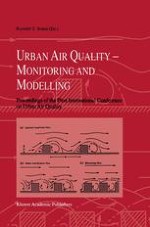1998 | OriginalPaper | Chapter
Accurate Ozone Prognostic Patterns for Madrid Area by Using A High Spatial and Temporal Eulerian Photochemical Model
Authors : R. San José, J. Cortés, J. F. Prieto, R. M. González
Published in: Urban Air Quality: Monitoring and Modelling
Publisher: Springer Netherlands
Included in: Professional Book Archive
Activate our intelligent search to find suitable subject content or patents.
Select sections of text to find matching patents with Artificial Intelligence. powered by
Select sections of text to find additional relevant content using AI-assisted search. powered by
The ANA Air Quality Model (ANA stands for Atmospheric Mesoscale Numerical Pollution Model for Regional and Urban Areas) has been applied over Madrid during a five day period in June, 1995. The domain is 80 × 100 km2 and the spatial resolution is 2000 m. The ANA system is driven by a meteorological model REMEST and it includes a detailed emission model for anthropogenic and biogenic sources with 250 m spatial resolution and 60 minutes temporal resolution. Different deposition processes are used such as the Wesely (1989) and Erisman et al. (1994) resistance approaches and the simple aerodynamic resistance. The photochemical processes and the general chemistry is based on the CBM-IV mechanism for the organic compounds and solved by the SMVGEAR method (CHEMA module).The model uses 14 different landuse types which are obtained by using the REMO module which uses the information provided by the LANDSAT-5 satellite image over the domain. The emission module EMJMA takes into account the point, line and area emissions over the domain. Special importance is given to the biogenic emissions which are obtained by using the satellite landuse classification for caducous, perenneal and mixed terrain. The emission module considers the EPA and CORINAIR emission factors. The results show an accurate prediction of the ozone maxima for the five days and also the general pattern of the ozone observed data. The five day simulation is characterized by a local low pressure over the Madrid Area and high pressures over Spain and West of Europe. The ozone surface patterns show the diurnal cycle and the maxima concentrations up to 140–160 ppb for suburban areas during afternoon hours. The general performance of the model is considered quite good. The computer power requirements continue to be very high for standard workstations. Future progress on parallel platforms should improve considerably the computer time requirements.
